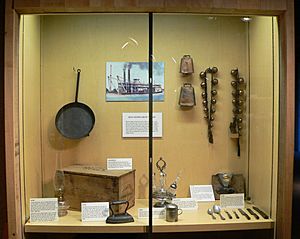Bertrand (steamboat) facts for kids
Quick facts for kids |
|
|
Bertrand Site
|
|

Model of the Bertrand
|
|
| Nearest city | Blair, Nebraska |
|---|---|
| Built | 1864 |
| NRHP reference No. | 69000138 |
| Added to NRHP | March 24, 1969 |
The Bertrand was a steamboat that sank on April 1, 1865. It was carrying goods up the Missouri River to Virginia City, Montana. The boat hit a hidden log in the river north of Omaha, Nebraska.
More than 100 years later, in 1968, half of its cargo was found. Today, these items are on display in a museum. This museum is at the DeSoto National Wildlife Refuge near Missouri Valley, Iowa. The collection is the largest group of Civil War-era items found together. It's like a time capsule showing daily life from that time.
Contents
History of the Steamboat Bertrand
The Bertrand steamboat was built in Wheeling, West Virginia in 1864. It was 161 feet (49 meters) long and 32 feet (9.8 meters) wide. The boat weighed 251 tons. It was a "shallow-draft" boat, meaning it didn't need much water to float. It only needed 18 inches (46 cm) of water when empty.
Gold Rush and River Trade
Steamboats started traveling up the Missouri River to Fort Benton, Montana in 1859. In 1863, gold was found in Montana at a place called Alder Gulch. Many people hoping to find gold moved to the area. This led to the growth of Virginia City, Montana, a very busy frontier town. Within a year, over 35,000 people lived near the gold discovery.
A company called Montana and Idaho Transportation Line owned the Bertrand. They shipped goods up the Missouri River to the Montana Territory. They also used ox trains to deliver goods to places far from the river. Gold miners and settlers needed many supplies. By 1867, Virginia City had 113 different businesses. The Missouri River was a key route for these gold mines and towns.
River routes were also important for the North American fur trade. This trade had been going on since the early 1800s. Boats like the Bertrand carried goods upriver and brought furs back down. In 1865, the Bertrand brought 260 packs of furs to St. Louis.
The trip from St. Louis to Montana Territory took about two months. It was often dangerous because the region was wild. There was also a chance of meeting hostile Native American tribes. But the chance to make money was worth the risks. Merchants made good profits by supplying the settlers' needs.
The Sinking of the Bertrand
On April 1, 1865, Captain James Yore was in charge of the Bertrand. The steamboat hit a hidden log in the Missouri River. This happened in the Desoto Bend, about 25 miles (40 km) north of Omaha, Nebraska.
The boat sank in 12 feet (3.7 meters) of water in less than ten minutes. Luckily, no one died. But almost all the cargo was lost. The boat and its cargo were worth about $100,000 at that time.
Discovery and Preservation
More than 100 years later, in 1968, two private salvagers found the wreck. They were Sam Corbino and Jesse Pursell. The boat was found on government land, so they had to follow the Antiquities Act of 1906. This law meant they gave all the recovered items to the U.S. Fish and Wildlife Service. This was for their permanent protection.
Workers recovered over 500,000 items from the boat's cargo area. These items show what life was like in 1865. They are now on display at the museum at the DeSoto National Wildlife Refuge.
Excavated Artifacts
The cargo found on the Bertrand gives us a special look into life in Virginia City, Montana Territory. The steamboat was full of clothes, tools, food, and other goods. These were all on their way up the river.
What Was Found
The ship's cargo was huge, about 283 cubic meters. It included:
- Dried and salted meats like beef, mutton, and pork.
- Oysters, pepper sauce, strawberries, peaches, and peanuts.
- Mustard from France.
- Many bottles of whiskey, including bourbon, brandy, and brandied cherries.
- Medicine bottles.
There were over 3,000 clothing items. These included gloves, hats, trousers, and 137 men's coats in seven different styles. Household items like mirrors, clocks, and silverware were also found. There were also building supplies for the growing town. Most of the goods were for a store in Virginia City called Vivian and Simpson. Some would also have been sold in nearby towns.
The ship also carried everything needed for gold mining. This included blasting powder, pickaxes, and shovels. All the goods were insured, so the merchants were paid back for their losses.
Life on the Frontier
The items show that people on the frontier were not cut off from the rest of the country. They had access to many goods and fashions. The artifacts from the Bertrand show what kinds of goods traveled from St. Louis to Montana Territory. This was an important time in American history. River travel and steamboats played a big role in settling and developing America.
In 1974, some canned food from the wreck was tested. This included brandied peaches, oysters, plum tomatoes, honey, and mixed vegetables. Scientists found no harmful germs. The food was still safe to eat, even after more than 100 years!





